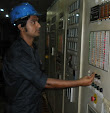Thermocouple Assemblies
A complete thermocouple sensing assembly generally consists of one or more of the following: a sensing element assembly (the junction), a protective tube (ceramic or metal jackets), a thermowell (for some critical applications, these are drilled solid bar stocks which are made to precise tolerances and are highly polished to inhibit corrosion), and terminations (contacts which may be in the form of a screw type, open type, plug and jack disconnect, military-standard-type connectors, etc.). Some typical thermocouple assemblies are shown in Fig.below.
The wires may be left bare or given electrical isolators. For the high-temperature applications, the isolators may be of a fish-spine or ball ceramic type, which provide sufficient flexibility. If thermocouple wires are not electrically isolated, a measurement error may occur. In-sulation is affected adversely by moisture, abrasion, flexing, temperature extremes, chemical attack, and nuclear radiation. A good knowledge of particular limitations of insulating materials is essential for accurate and reliable measurement. Some insulations have a natural moisture resistance. Teflon, polyvinyl chloride (PVC), and some forms of polyimides are examples of this group. With the fiber-type insulations, moisture protection results from impregnating with substances such as wax, resins, or silicone compounds. It should be noted that only one-time exposure to ultraextreme temperatures cause evaporation of the impregnating materials and loss of protection. The moisture penetration is not confined to the sensing end of the assembly. For example, if a thermocouple passes through hot or cold zones, condensation may produce errors in the measurement, unless adequate moisture protection is provided.
The basic types of flexible insulation for elevated temperature usage are fiber glass, fibrous silica, and asbestos (which should be used with proper precaution due to health hazard). In addition, thermocouples must be protected from atmospheres that are not compatible with the alloys. Protecting tubes serve the double purpose of guarding the thermocouple against mechanical damage and interposing a shield between the wires and the environment. The protecting tubes can be made of carbon steels (up to 540◦C in oxidizing atmospheres), stainless steel (up to 870◦C), ferric stainless steel (AISI 400 series), and high-nickel alloys (Nichrome,6 Inconel,7 etc.) (up to 1150◦C in oxidizing atmospheres). Practically all base–metal thermocouple wires are annealed or given a “stabi-lizing heat treatment” by the manufacturer. Such treatment generally is considered sufficient, and seldom is it found advisable to further anneal the wire before testing or using. Although a new platinum and platinum–rhodium thermocouple wire as sold by some manufacturers is annealed already, it has become a regular practice in many laboratories to anneal all Type R, S, and B thermocouples, whether new or previ- ously used, before attempting an accurate calibration. This is accomplished usually by heating the thermocouple electrically in air. The entire thermocouple is supported between two binding posts, which should be close together, so that the tension in the wires and stretching while hot are kept at a minimum. The temperature of the wire is conveniently determined with an optical pyrometer. Most of the mechanical strains are relieved during the first few minutes of heating at 1400–1500◦C. Thin-film thermocouples are formed by bonding junctions of foil metals. They are available in a free-filament style with a removable carrier and in a matrix style with a sensor embedded in a thin laminated material. The foil having a thickness in the order of 5 µm (0.0002 in.) gives an extremely low mass and thermal capacity. Thin flat junctions may provide intimate thermal coupling with the measured surface. Foil thermocouples are very fast (a typical thermal time constant is 10 ms) and can be used with any standard interface electronic apparatuses.
While measuring temperature with sensors having small mass, thermal conduction through the connecting wires always must be taken into account. Because of a very large length-to-thickness ratio of the film thermocouples (on the order of 1000), heat loss via wires is usually negligibly small. To attach a film thermocouple to an object, several methods are generally used. Among them are various cements and flame or plasma-sprayed ceramic coatings. For ease of handling, the sensors often are supplied on a temporary carrier of polyimide film which is tough, flexible, and dimensionally stable. It is exceptionally heat resistant and inert. During the installation, the carrier can be easily peeled off or released by application of heat. The free foil sensors can be easily brushed into a thin layer, to produce an ungrounded junction. While selecting cements, care must be taken to avoid corrosive compounds. For instance, cements containing phosphoric acid are not recommended for use with thermocouples having copper in one arm.









